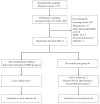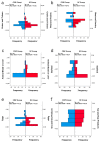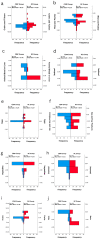Effects of a Comprehensive Dietary Intervention Program, Promoting Nutrition Literacy, Eating Behavior, Dietary Quality, and Gestational Weight Gain in Chinese Urban Women with Normal Body Mass Index during Pregnancy
- PMID: 38257110
- PMCID: PMC10820561
- DOI: 10.3390/nu16020217
Effects of a Comprehensive Dietary Intervention Program, Promoting Nutrition Literacy, Eating Behavior, Dietary Quality, and Gestational Weight Gain in Chinese Urban Women with Normal Body Mass Index during Pregnancy
Abstract
In urban Chinese women with normal body weight during pregnancy, we implemented a comprehensive dietary intervention program aimed at enhancing nutrition literacy, dietary quality, and gestational weight gain. The methods included both online and offline health education on prenatal nutrition, weekly weight monitoring, family back education practices, and real-time dietary guidance. The intervention was delivered to randomly assigned control and intervention group participants from gestational week 12 to week 24. The intervention group (n = 44; 100% complete data) showed significant differences (mean (SD)) compared to the control group (n = 42; 95.5% complete data) in nutrition literacy (53.39 ± 6.60 vs. 43.55 ± 9.58, p < 0.001), restrained eating (31.61 ± 7.28 vs. 28.79 ± 7.96, p < 0.001), Diet Quality Distance (29.11 ± 8.52 vs. 40.71 ± 7.39, p < 0.001), and weight gain within the first 12 weeks of intervention (4.97 ± 1.33 vs. 5.98 ± 2.78, p = 0.029). However, there was no significant difference in the incidence of gestational diabetes (2 (4.5%) vs. 4 (9.5%), p = 0.629). Participants in the intervention group reported an overall satisfaction score of 4.70 ± 0.46 for the intervention strategy. These results emphasize the positive role of comprehensive dietary intervention in promoting a healthy diet during pregnancy.
Keywords: digital; eating behavior; health literacy; intervention; nutrition; pregnancy; weight.
Conflict of interest statement
The authors declare no conflicts of interest. The funders had no role in the design of the study; in the collection, analyses, or interpretation of data; in the writing of the manuscript; or in the decision to publish the results.
Figures















Similar articles
-
The effect of weight management interventions that include a diet component on weight-related outcomes in pregnant and postpartum women: a systematic review protocol.JBI Database System Rev Implement Rep. 2015 Jan;13(1):88-98. doi: 10.11124/jbisrir-2015-1812. JBI Database System Rev Implement Rep. 2015. PMID: 26447010
-
Effect of antenatal dietary interventions in maternal obesity on pregnancy weight-gain and birthweight: Healthy Mums and Babies (HUMBA) randomized trial.Am J Obstet Gynecol. 2019 Aug;221(2):152.e1-152.e13. doi: 10.1016/j.ajog.2019.03.003. Epub 2019 Mar 13. Am J Obstet Gynecol. 2019. PMID: 30878323 Clinical Trial.
-
A mobile health intervention promoting healthy gestational weight gain for women entering pregnancy at a high body mass index: the txt4two pilot randomised controlled trial.BJOG. 2017 Oct;124(11):1718-1728. doi: 10.1111/1471-0528.14552. Epub 2017 Feb 20. BJOG. 2017. PMID: 28220604 Clinical Trial.
-
The importance of nutrition in pregnancy and lactation: lifelong consequences.Am J Obstet Gynecol. 2022 May;226(5):607-632. doi: 10.1016/j.ajog.2021.12.035. Epub 2021 Dec 27. Am J Obstet Gynecol. 2022. PMID: 34968458 Free PMC article. Review.
-
Interventions including a nutrition component aimed at managing gestational weight gain or postpartum weight retention: a systematic review and meta-analysis.JBI Database System Rev Implement Rep. 2019 Mar;17(3):297-364. doi: 10.11124/JBISRIR-2017-003593. JBI Database System Rev Implement Rep. 2019. PMID: 30870329
Cited by
-
Effects of 12-Week Dietary Inflammatory Index-Based Dietary Education on Frailty Status in Frail Patients with Colorectal Cancer: A Randomized Controlled Trial.Nutrients. 2025 Jul 1;17(13):2203. doi: 10.3390/nu17132203. Nutrients. 2025. PMID: 40647307 Free PMC article. Clinical Trial.
-
Healthy Nutrition as the Key Reference in Special Diets, Quality of Life, and Sustainability.Nutrients. 2024 Aug 30;16(17):2906. doi: 10.3390/nu16172906. Nutrients. 2024. PMID: 39275222 Free PMC article.
-
Nutrition literacy and its relationship with diet quality and quality of life among white-collar employees: a study from Türkiye.BMC Public Health. 2024 Dec 18;24(1):3478. doi: 10.1186/s12889-024-21078-4. BMC Public Health. 2024. PMID: 39696267 Free PMC article.
-
Effects of Cognitive Behavioral Therapy for Diet on Postprandial Glucose and Pregnancy Outcomes in Gestational Diabetes Mellitus: Multicenter Randomized Controlled Trial.J Med Internet Res. 2025 Jul 29;27:e71075. doi: 10.2196/71075. J Med Internet Res. 2025. PMID: 40729762 Free PMC article. Clinical Trial.
References
-
- Cao L.J., Lin H.Y., Liang X., Chen Y.J., Liu Y.Y., Zheng Y.Z., Wang X.Y., Li W., Yan J., Huang G.W. Association between Pre-pregnancy Body Mass Index and Offspring Neuropsychological Development from 1 to 24 Months of Age: A Birth Cohort Study in China. Biomed. Environ. Sci. 2019;32:730–738. - PubMed
-
- Eloranta A.M., Gunnarsdottir I., Thorisdottir B., Gunnlaugsson G., Birgisdottir B.E., Thorsdottir I., Einarsdóttir K. The combined effect of pre-pregnancy body mass index and gestational weight gain on the risk of pre-labour and intrapartum caesarean section-The ICE-MCH study. PLoS ONE. 2023;18:e0280060. doi: 10.1371/journal.pone.0280060. - DOI - PMC - PubMed
-
- Ke J.-F., Liu S., Ge R.-L., Ma L., Li M.-F. Associations of maternal pre-pregnancy BMI and gestational weight gain with the risks of adverse pregnancy outcomes in Chinese women with gestational diabetes mellitus. BMC Pregnancy Childbirth. 2023;23:414. doi: 10.1186/s12884-023-05657-8. - DOI - PMC - PubMed
-
- Jiajin H. Effects of Weight Gain during Pregnancy on Maternal and Child Health Outcomes and Research on Weight Management Methods during Pregnancy. China Medical University; Taichung, Taiwan: 2019.
Publication types
MeSH terms
Grants and funding
- 2023,6435675/The graduate program, Faculty of Medicine Ramathibodi Hospital
- Student ID: QIAN LI, G6436675/Research grants scholarships to undergraduate students under the Doctor of Philosophy Program in Nursing Science (International Program), Faculty of Medicine Ramathibodi Hospital and Faculty of Nursing, Mahidol University
LinkOut - more resources
Full Text Sources

